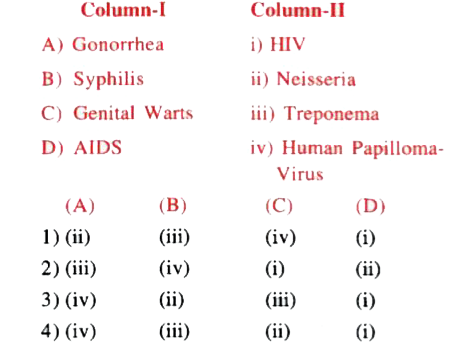During secondary growth in dicot stem complimentary cells are formed from
Interfascicular cambium
Vascular cambium
Phellogen
2 and 3
The correct Answer is:C
Step-by-Step Solution:
1. Understanding Secondary Growth in Dicot Stem:
- Secondary growth refers to the increase in the girth of the plant stem and roots, primarily occurring in dicots and gymnosperms. This growth is facilitated by the activity of the cambium.
2. Identifying the Role of Cambium:
- Cambium is a type of meristematic tissue responsible for secondary growth. It consists of two types: the vascular cambium and the cork cambium (also known as phellogen).
3. Differentiating Between Types of Cambium:
- The vascular cambium produces secondary xylem (wood) and secondary phloem (bark). The cork cambium (phellogen) produces cork cells, which are part of the protective outer layer of the stem.
4. Understanding Complementary Cells:
- Complementary cells are associated with the cambium and play a role in the structure and function of the plant, particularly in gas exchange and providing strength.
5. Identifying the Source of Complementary Cells:
- In the context of the question, complementary cells during secondary growth in a dicot stem are formed from the cork cambium (phellogen). This is because the cork cambium is responsible for producing the outer protective layer and associated cells.
6. Conclusion:
- Therefore, the correct answer to the question is that during secondary growth in a dicot stem, complementary cells are formed from the cork cambium, also known as phellogen.
Final Answer:
Complementary cells during secondary growth in a dicot stem are formed from the cork cambium (phellogen).
---
- Secondary growth refers to the increase in the girth of the plant stem and roots, primarily occurring in dicots and gymnosperms. This growth is facilitated by the activity of the cambium.
- Cambium is a type of meristematic tissue responsible for secondary growth. It consists of two types: the vascular cambium and the cork cambium (also known as phellogen).
- The vascular cambium produces secondary xylem (wood) and secondary phloem (bark). The cork cambium (phellogen) produces cork cells, which are part of the protective outer layer of the stem.
- Complementary cells are associated with the cambium and play a role in the structure and function of the plant, particularly in gas exchange and providing strength.
- In the context of the question, complementary cells during secondary growth in a dicot stem are formed from the cork cambium (phellogen). This is because the cork cambium is responsible for producing the outer protective layer and associated cells.
- Therefore, the correct answer to the question is that during secondary growth in a dicot stem, complementary cells are formed from the cork cambium, also known as phellogen.
Complementary cells during secondary growth in a dicot stem are formed from the cork cambium (phellogen).
Topper's Solved these Questions
- HISTOLOGY AND ANATOMY OF FLOWERING PLANTSBOOK - AAKASH SERIESCHAPTER - HISTOLOGY AND ANATOMY OF FLOWERING PLANTSEXERCISE - EXERCISE - II
214 Videos
- HISTOLOGY AND ANATOMY OF FLOWERING PLANTSBOOK - AAKASH SERIESCHAPTER - HISTOLOGY AND ANATOMY OF FLOWERING PLANTSEXERCISE - EXERCISE - III (PREVIOUS AIPMT/NEET QUESTIONS)
24 Videos
- HISTOLOGY AND ANATOMY OF FLOWERING PLANTSBOOK - AAKASH SERIESCHAPTER - HISTOLOGY AND ANATOMY OF FLOWERING PLANTSEXERCISE - EXERCISE - I (ANATOMY OF DICOTYLEDONOUS AND MONOCOTYLEDONOUS PLANTS)
60 Videos
- ENVIRONMENTAL ISSUESBOOK - AAKASH SERIESCHAPTER - ENVIRONMENTAL ISSUESEXERCISE - Exercise-III (Previous AIPMT/NEET Questions)
41 Videos
- HUMAN HEALTH DISEASEBOOK - AAKASH SERIESCHAPTER - HUMAN HEALTH DISEASEEXERCISE - EXERCISE - III (PREVIOUS AIPMT/NEET QUESTIONS)
56 Videos
Similar Questions
Histogen theory was proposed by
View SolutionCortex is the region found between
View SolutionCasparian strip is a characteristic feature of
View SolutionWhich of the following in sewage treatment removes suspended solids?
View SolutionMatch the following sexually transmitted diseases (Colum-I) with their causative agent (Column -II) and select the correct option.

View SolutionWhat forms the cambial ring in a dicot stem during the secondary growth ?
View Solutionद्वितीयक वृद्धि किसे कहते हैं ? द्विबीजपत्री तने में द्वितीयक वृद्धि किस प्रकार से होती हैं ?
View SolutionWhat forms the cambial ring in a dicot stem during the secondary growth?
View SolutionSecondary Growth of Dicot stem
View SolutionWhat forms the cambial ring in a dicot stem during the secondary growth?
View SolutionDepict the tissue lineage during secondary growth in dicot stem and root .
View SolutionSecondary growth does not occur in monocot/dicot stem.
View Solutionद्विबीजपत्री तने में द्वितीयक वृद्धि होती है
View SolutionDuring secondary growth in dicot stem complimentary cells are formed from
View SolutionIn dicot root, during secondary growth, vascular cambium is formed from
View SolutionDescribe briefly the secondary growth in a dicot stem ?
View Solution

